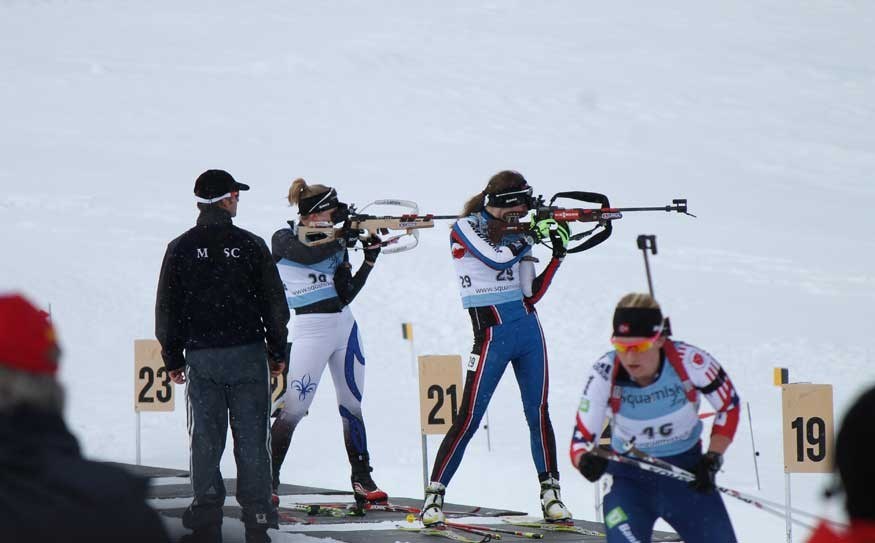Aside from the sports of Nordic combined and ski jumping, no other Olympic winter sport receives less funding from Own the Podium (OTP) than biathlon.
In the 2012-2013 season, OTP gave just $200,000 to Biathlon Canada, which is double what Ski Jumping Canada received. Nordic combined received nothing.
Own the Podium bases funding on results and what they believe a sports' future prospects are on the World Stage. For example, the sports of bobsleigh and skeleton, which earned four medals for Canada in the 2010 Olympic Winter Games, saw $2.25 million from OTP this season. The national freestyle team, which is dominating the World Cup, received $2.74M.
Kaile McKenna, the interim executive director for Biathlon Canada, said they hope to change that funding equation going into the 2013-2014 Olympic year, based on the results on the national team.
Jean-Philippe Le Guellec became the first Canadian male to win a biathlon World Cup medal with a gold medal performance back in December, while the men's and women's relay teams had solid results at the World Championships in placing eighth and 12th respectively. Consistency and overall results have improved for the team, which successfully maxed out quota spots for the 2014 Olympics by qualifying the full four men and women.
"Every year we apply for annual funding, and we're in the process of going through our budgeting for next year," said McKenna, in Whistler this week for the Biathlon national championship races at Whistler Olympic Park. "I think JP's win is going to help us, and we can hopefully leverage that with our financial proposals as we move into the next year.
"Funding is definitely important. It's not a cheap sport, there's lots of travel involved, there are a lot of costs for coaching, and sponsorship would be huge for us... we hope to see more funding from Own the Podium and Sports Canada, but sponsorship is also something we hope JP's win will help us leverage."
McKenna said there's already been some interest from sponsors, but they will be making a big push to have some stable, non-governmental funding in the off-season.
As for the team's prospects, high performance director Chris Lindsay said the talent pool is increasing.
"Right now we have three full-time coaches working for the association, and we're ready to do a final retooling after our experience's on the World Cup circuit this year," he said. "We know what we're up against, and we'll need to make some minor changes to make sure our athletes are prepared and we'll be good to go to Sochi.
"The reality is that we've done well, but other sports are also doing well and the pie doesn't get any bigger unfortunately — or it slowly gets bigger. The government is putting more money into sports, which is fantastic, but it's going to take increasing our non-government funding to really make a difference."
Lindsay said the main focus for the team is the sprint race, where athletes race two laps of a course —10km for men and 7.5km for women — stopping at the range twice; they shoot once prone and one standing, and do a lap of a 150-metre penalty loop for every missed shot.
It's a very strategic sport, and athletes have to learn to slow their hearts down from close to the maximum to a level where they can focus and hold the rifle steady enough to hit five small targets 50 yards away. The goal is to shoot quickly, but slowly enough to avoid missing shots and making penalty laps.
The sprint event also feeds directly into the pursuit race the next day as athletes leave the start line of the pursuit in the order they finished the sprint. If you finish first in the sprint by 10 seconds then you have a 10 second head-start on the second-place competitor in the pursuit.
"If you don't make the top 60 then you're not going to ski the next day, so sprint is a huge focus for us," said Lindsay.
The four Canadian athletes that have already met the team's qualifications for 2014 are JP Le Guellec and Scott Perras on the men's side, and Zina Kocher and Rosanna Crawford on the women's side. There are three World Cup events before the team's cutoff on Dec. 23 for other athletes to qualify, and if two athletes are tied then there will be a tie-breaker event in early January.
Success in biathlon also means developing grass roots programs to develop athletes. At Whistler Olympic Park, biathlon is championed by the Callaghan Winter Sports Club, which hosts youth programs for ages eight and up, as well as masters programs.
For more on local biathlon visit www.callaghanwintersportsclub.ca.




